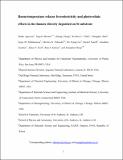Files in this item
Room-temperature relaxor ferroelectricity and photovoltaic effects in tin titanate directly deposited on silicon substrate
Item metadata
| dc.contributor.author | Agarwal, R | |
| dc.contributor.author | Sharma, Y | |
| dc.contributor.author | Chang, S | |
| dc.contributor.author | Pitike, K | |
| dc.contributor.author | Sohn, C | |
| dc.contributor.author | Nakhmanson, S | |
| dc.contributor.author | Takoudis, C | |
| dc.contributor.author | Lee, H | |
| dc.contributor.author | Tonelli, R | |
| dc.contributor.author | Gardner, Jonathan | |
| dc.contributor.author | Scott, James F. | |
| dc.contributor.author | Katiyar, R | |
| dc.contributor.author | Hong, S | |
| dc.date.accessioned | 2018-02-06T11:30:20Z | |
| dc.date.available | 2018-02-06T11:30:20Z | |
| dc.date.issued | 2018-02-20 | |
| dc.identifier | 252181587 | |
| dc.identifier | 90cf318a-9417-4bc3-852b-9c49dd5b4595 | |
| dc.identifier | 85043754235 | |
| dc.identifier | 000425491500002 | |
| dc.identifier.citation | Agarwal , R , Sharma , Y , Chang , S , Pitike , K , Sohn , C , Nakhmanson , S , Takoudis , C , Lee , H , Tonelli , R , Gardner , J , Scott , J F , Katiyar , R & Hong , S 2018 , ' Room-temperature relaxor ferroelectricity and photovoltaic effects in tin titanate directly deposited on silicon substrate ' , Physical Review. B, Condensed matter and materials physics , vol. 97 , no. 5 , 054109 . https://doi.org/10.1103/PhysRevB.97.054109 | en |
| dc.identifier.issn | 1098-0121 | |
| dc.identifier.uri | https://hdl.handle.net/10023/12676 | |
| dc.description.abstract | Tin titanate (SnTiO3) has been notoriously impossible to prepare as a thin-film ferroelectric, probably because high-temperature annealing converts much of the Sn2+ to Sn4+. In the present paper, we show two things: first, perovskite phase SnTiO3 can be prepared by ALD directly onto p-type Si substrates; and second, these films exhibit ferroelectric switching at room temperature, with p-type Si acting as electrodes. X-ray diffraction (XRD) measurements reveal that the film is single-phase, preferred-orientation ferroelectric perovskite SnTiO3. Our films showed well-saturated, square and repeatable hysteresis loopsof around 3 μC/cm2 remnant polarization at room temperature, as detected by out-of-plane polarization versus electric field (P-E) and field cycling measurements. Furthermore, photovoltaic and photoferroelectricity were found in Pt/SnTiO3/Si/SnTiO3/Pt heterostructures, of which properties can be tuned through band gap engineering by strain according to the first-principles calculations. This is a new lead-free room-temperature ferroelectric oxide of potential device application. | |
| dc.format.extent | 822872 | |
| dc.format.extent | 758868 | |
| dc.language.iso | eng | |
| dc.relation.ispartof | Physical Review. B, Condensed matter and materials physics | en |
| dc.subject | QC Physics | en |
| dc.subject | T Technology | en |
| dc.subject | NDAS | en |
| dc.subject | SDG 7 - Affordable and Clean Energy | en |
| dc.subject.lcc | QC | en |
| dc.subject.lcc | T | en |
| dc.title | Room-temperature relaxor ferroelectricity and photovoltaic effects in tin titanate directly deposited on silicon substrate | en |
| dc.type | Journal article | en |
| dc.contributor.institution | University of St Andrews. School of Chemistry | en |
| dc.contributor.institution | University of St Andrews. School of Physics and Astronomy | en |
| dc.contributor.institution | University of St Andrews. Condensed Matter Physics | en |
| dc.identifier.doi | https://doi.org/10.1103/PhysRevB.97.054109 | |
| dc.description.status | Peer reviewed | en |
This item appears in the following Collection(s)
Items in the St Andrews Research Repository are protected by copyright, with all rights reserved, unless otherwise indicated.


